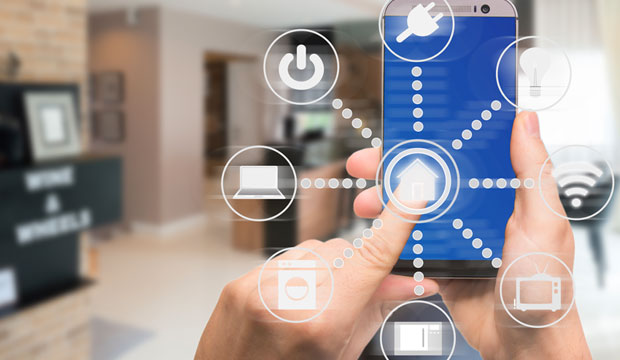Annual sales of all connected home devices are expected to exceed 520 million units by 2022, based on Parks Associates forecasts. Specific use cases for artificial intelligence in the smart home will help drive adoption of new devices and services as intelligent outcomes increase product value.
In addition to security use cases, which are the leading drivers of adoption, the broader smart home automation segment encompasses standalone devices and smart home systems that seek to unify control for lights, locks, thermostats, entertainment devices, and other subsystems.
Smart home control may be achieved via self-installed DIY systems (SmartThings, Wink), pro-installed systems offered by security services (ADT Pulse, Alarm.com), or custom installing smart home dealers (Control4, Crestron).
Smart home control also may be achieved through cloud-to-cloud integrations of point solutions, or systems that do not rely on traditional hardware controllers (Amazon Alexa, Google Home, Works with Nest, various WiFi device API integrations).
AI can be applied to data from any of these home automation devices or systems to anticipate and predict user behavior, provide maintenance data, or help increase data security and privacy.

Despite the explosion of smart home products and services, hardware controllers such as security panels and home control hubs have shown only modest growth in recent years.
In Q4 2017, 13 percent of U.S. broadband households reported ownership of a home controller, and by 2022, annual revenue from home controllers is expected to reach $2.7 million. Local smart home controller hardware can assist AI at the edge by leveraging processing power and memory in order to reduce latency and increase data security and privacy.
Whether enabled by local hardware or cloud-based intelligence, AI applications will enhance the user experience and add value to the smart home in some of the following ways.
Predictive and Personalized Automation
As AI-powered analytics are applied to the repetitive patterns of daily life, the smart home application can learn the occupants’ routines and make predictive recommendations for automation sequences that make life more secure, safe, comfortable, and convenient.
For example, after learning a pattern of behavior that includes a door unlocking, a light being turned on, and movement through several rooms of the home, the system can recommend that all of these actions be synchronized and automated in an “arrival scene” that will be triggered when the occupant’s smartphone gets within a certain proximity to the home as identified by geofencing.
Array by Hampton showcases this potential with its smart home products that are integrated and controlled through the Array app. The app enables geofencing, automation, and access management via e-keys and e-codes. By applying machine learning, the occupant doesn’t have to create the scene but just affirm the creation of it, perhaps even more conveniently by voice.
Similarly, by knowing which occupant is arriving, personalized settings can be triggered for lighting, thermostat settings, entertainment preferences, etc. Machine learning can adjust these settings as the occupant’s behavior changes over time or other contextual factors come into play, such as time of year, day of the week, presence of others in the home, or weather conditions.
Home, away, sleep and vacation modes are contextual rubrics that inform personalized automation. The primary value of machine learning for intelligent automation is in a vastly improved user experience that requires less effort by the owner. An intelligent system takes care of the occupants and provides them with a higher level of protection.
More autonomously designed systems have been entering the market. After a brief period of learning the occupant’s patterns, an autonomous system will enable automations without requiring the user to do anything. The system defaults to machine autonomy rather than requesting permission. Some consumers may find this very convenient, while others may not be ready to cede that much control of the home.
Predictive Maintenance
Machine learning, originally applied to enterprise facilities management and the industrial Internet of Things, is beginning to be applied to device telemetry data from consumer-grade connected HVAC systems, refrigerators, and clothes washers and dryers.
By anticipating potential problems and intervening, predictive maintenance offers benefits over reactive maintenance (fix after a problem occurs) and preventive maintenance (recommended actions taken to maintain devices but uninformed by actual condition of the device).
Product performance diagnostics, run times, power usage patterns, total hours in service, filter or coolant status, and other metrics can provide key indicators of potential maintenance issues that either can be addressed proactively at a convenient time, or even prevented. Machine learning applied across a large data set of installed devices yields performance patterns that are not visible in a small sample base.
LG announced at last year’s CES that the company would be adding its ThinQ artificial intelligence capabilities to all of its products. Along with remote access and monitoring, voice control, and inter-appliance communication, its smart appliances are capable of self-diagnostics.
The AI can detect maintenance issues before they occur on any of its smart home appliances and automatically notify the user, the company claimed. To accelerate repair times, the app also will send a maintenance alert to a call center or the company’s engineers.
Public cloud platforms, such as Microsoft Azure and Amazon Web Services, offer machine learning tools that are preconfigured for different types of predictive maintenance use cases.
Similarly, Mnubo has applied its SmartObjects machine learning platform to develop predictive maintenance analytics for connected heating ventilation air conditioning and refrigeration units (HVACRs).
The application measures flow, temperature, pressure and vibration levels in real-time, then stores and analyzes the HVACR’s diagnostic events data to determine trends and patterns, and highlight potential issues.
The manufacturer is notified of issues, anomalies and abnormal behavior, as well as operational issues such as temperature and vibration fluctuations. As machine learning is applied over time to the failure and anomaly dataset, the service can build predictive maintenance models that can spotlight issues before they occur, and enable the manufacturer to take proactive measures to address equipment issues.
Predictive maintenance applications for consumer electronics and appliances offer long-term value for customer engagement, product development and optimization, and new revenue from repairs, referrals, parts, and replenishment of consumables such as filters and fluids.
Unlike predictive maintenance applications for enterprise and industrial IoT, those for consumer products do not produce short-term operational efficiencies, reduce maintenance costs and truck rolls, or reduce losses from downtime.
Without this more immediate ROI, maintenance applications will experience slower implementation. Forward-thinking companies, however, will see predictive maintenance as a means to engage the customer throughout the product lifecycle, which will continually position their brands for cross-selling and upselling opportunities.
Interactions with consumers around AI-driven features are best treated gently and incrementally. Recommendations can lead to nudges that can lead to full automation after the user has affirmed certain courses of action or preferences.
Consumer control and confidence in data sharing are critical. The intelligence of a product or system best functions as an extension of the owner’s intelligence that offers more convenience, safety, savings, and peace of mind.














































